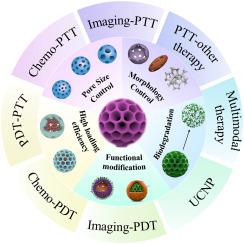Journal of Controlled Release ( IF 10.5 ) Pub Date : 2021-10-09 , DOI: 10.1016/j.jconrel.2021.10.005 Kaili Wang 1 , Junya Lu 1 , Jiali Li 1 , Yinlu Gao 1 , Yuling Mao 1 , Qinfu Zhao 1 , Siling Wang 1

|
Photoactivated therapeutic strategies (photothermal therapy and photodynamic therapy), due to the adjusted therapeutic area, time and light dosage, have prevailed for the fight against tumors. Currently, the monotherapy with limited treatment effect and undesired side effects is gradually replaced by multimodal and multifunctional nanosystems. Mesoporous silica nanoparticles (MSNs) with unique physicochemical advantages, such as huge specific surface area, controllable pore size and morphology, functionalized modification, satisfying biocompatibility and biodegradability, are considered as promising candidates for multimodal photoactivated cancer therapy. Excitingly, the innovative nanoplatforms based on the mesoporous silica nanoparticles provide more and more effective treatment strategies and display excellent antitumor potential. Given the rapid development of antitumor strategies based on MSNs, this review summarizes the current progress in MSNs-based photoactivated cancer therapy, mainly consists of (1) photothermal therapy-related theranostics; (2) photodynamic therapy-related theranostics; (3) multimodal synergistic therapy, such as chemo-photothermal-photodynamic therapy, phototherapy-immunotherapy and phototherapy-radio therapy. Based on the limited penetration of irradiation light in photoactivated therapy, the challenges faced by deep-seated tumor therapy are fully discussed, and future clinical translation of MSNs-based photoactivated cancer therapy are highlighted.
中文翻译:

用于光活化癌症治疗的智能介孔二氧化硅基纳米载体的当前趋势
光活化治疗策略(光热疗法和光动力疗法)由于调整了治疗区域、时间和光剂量,在对抗肿瘤方面占了上风。目前,治疗效果有限、副作用大的单一疗法逐渐被多模态多功能纳米系统所取代。介孔二氧化硅纳米粒子(MSNs)具有独特的物理化学优势,如巨大的比表面积、可控的孔径和形态、功能化修饰、令人满意的生物相容性和生物降解性,被认为是多模式光活化癌症治疗的有希望的候选者。令人兴奋的是,基于介孔二氧化硅纳米粒子的创新纳米平台提供了越来越有效的治疗策略,并显示出优异的抗肿瘤潜力。鉴于基于MSNs的抗肿瘤策略的快速发展,本文总结了基于MSNs的光活化癌症治疗的当前进展,主要包括(1)光热治疗相关的治疗诊断学;(2) 光动力疗法相关的治疗诊断学;(3)多模式协同治疗,如化学-光热-光动力治疗、光疗-免疫治疗和光疗-放射治疗。基于光活化治疗中照射光的穿透性有限,充分讨论了深部肿瘤治疗面临的挑战,并强调了基于 MSNs 的光活化癌症治疗的未来临床转化。主要包括(1)光热疗法相关的治疗诊断学;(2) 光动力疗法相关的治疗诊断学;(3)多模式协同治疗,如化学-光热-光动力治疗、光疗-免疫治疗和光疗-放射治疗。基于光活化治疗中照射光的穿透性有限,充分讨论了深部肿瘤治疗面临的挑战,并强调了基于 MSNs 的光活化癌症治疗的未来临床转化。主要包括(1)光热疗法相关的治疗诊断学;(2) 光动力疗法相关的治疗诊断学;(3)多模式协同治疗,如化学-光热-光动力治疗、光疗-免疫治疗和光疗-放射治疗。基于光活化治疗中照射光的穿透性有限,充分讨论了深部肿瘤治疗面临的挑战,并强调了基于 MSNs 的光活化癌症治疗的未来临床转化。









































 京公网安备 11010802027423号
京公网安备 11010802027423号